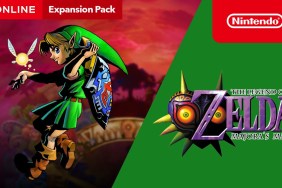The Philosopher’s Bricks.
The Lego series of video games is one of those things that, on the whole, actually turned out a heck of a lot better than it initially sounded: “We’re going to take [insert beloved franchise here] and—and do the whole thing with Legos! It’ll be totally family-friendly, so you can play it with little kids! And, and… there’ll be bricks, you know, and, you can… you know… build stuff…”
[image1]Thankfully, the high points—Lego Star Wars, Lego Indiana Jones, and Lego Batman—not only offered immersive, oft-humorous, and surprisingly intuitive gameplay, but a respectable lot of replay value as well. But what did the phenomenon really give gamers, beyond any of that?
I’ll tell you what it gave them—the desire to see still more of their favorite franchises given the delightful, good-natured Lego treatment. It’s certainly been a topic of fairly passionate, strident discussion around here: Where’s my damn Lego James Bond, already? Since the Lego games heretofore have successfully focused on popular film franchises, how about Back to the Future, or the Lord of the Rings Trilogy? And for that matter—now that the subject-material in question has triumphantly self-corrected after a fairly dismal decade—where in the Delta Triangle is Lego Star Trek?
Well, one thing at a time, I suppose. Developer Traveller’s Tales has climbed back on the broomstick, and last week we got our impatient, greedy, immature eyeballs on the forthcoming Lego Harry Potter: Years 1-4—and, by Severus Snape’s hooked honker, it’s looking like the franchise is in top form.
As the name clearly states, LHP:Y1-4 covers the first four novels/films in J.K. Rowling’s crazy-successful Harry Potter series: The Philosopher’s Stone, The Chamber of Secrets, The Prisoner of Azkaban, and The Goblet of Fire. While there’s a notable emphasis on item collection (and from what I saw, general ambient detail overall) this time around, LHP:Y1-4 features the same essential gameplay mechanics and features found in the earlier Lego games, including the humorous Simlish-speak cinematics that drive the story, the opportunity to bash almost anything to yield more Lego studs, and the capacity to provide both a wide-eyed youngster and a young-at-heart (or slightly-inebriated) adult with an engaging, entertainment experience at the same time. Hidden secrets and challenges abound, of course—should the more hardcore seek them out—but the game is designed to accommodate a wide range of ages.
[image2]One of the game’s new aspects is spell-casting, which is an essential component of the gameplay. Players quickly gain access to a radial interface of available spells; only a handful are available early on, but with progress through the game, more become unlocked. There are garden-variety fireballs, of course, which can be used either offensively or to throw switches at a distance; more sophisticated and integral to the game is the Wingardium Leviosa, a spell used to levitate objects—in this case Lego bricks, that can be manipulated and re-arranged to unblock passages, create bridges, or otherwise facilitate access to different parts of the game. Still another element is that of collecting and mixing potions in the proper proportions in various cauldrons; for completing levels, if you’re skilled or lucky… or, if you’re not as skilled or lucky, backfire-transmogrifying yourself into a frog. Whatever works.
Like Lego Indiana Jones 2 before it, LHP:Y1-4 employs an exceedingly elegant multiplayer screen-mechanic that allows the display to split when two cooperative players move too far away from each other, and to seamlessly merge again when said players return to a point where the camera has them both in the same field of view—it really has to be seen in action to be truly appreciated.
Speaking of which, LHP:Y1-4‘s most promising appeal-factor may be its sheer visual beauty—witness the amount of environmental detail in locales like Diagon Alley, The Forbidden Forest, the color-drained representations of (playable) events that have occurred in the past, and of course the sprawling entirety of Hogwarts itself. The infamous school serves not only as a massive, navigable, convincing locale in its own right, but also as something of a central hub in the game.
[image3]Seemingly everything onscreen has a game-relevant function, or at least a rewarding little easter-egg quality to it: Characters represented in wall-portraits will move and gesture, or even shuttle about from portrait to portrait as though through some magical hyper-space. Books will spread their leaves and flutter about like flocks of weird, hundred-winged birds. If you see a decorative basketball hoop outdoors, look around for a basketball; hell, before you even make it to Hogwarts proper, it’s easy and tempting to piss away a good half an hour or more just seeing how many tables, shop-stalls, and High Street signs you can mess with in Diagon Alley. This is being called the most detailed Lego game to date, and it’s sure looking that way.
And yes, since you’re going to ask—you bet your bespectacled, pubescent ass there are Quidditch broomsticks to cruise around on. (Nice Touch #42: Character proficiency is ‘locked’ to the canon of the books, so when Hermione or Ron try to test-drive a broomstick, it’s an awkward, wobbly affair. Harry is, on the other hand, a ‘natural’, and can control one handily, even cranking off magical shots at independent targets while doing so.
LHP:Y1-4 will feature local splitscreen and online co-op play (360 and PS3 only), and offer a roster of over 100 characters (Lego Alan Rickman—you know you want it). The game is slated to ship, for all platforms, in May 2010, and promises to be tuned for N.E.W.T. acers and muggles alike. Check back in May, when we conjure up our full review.







